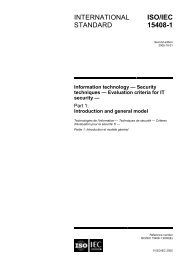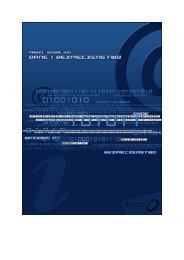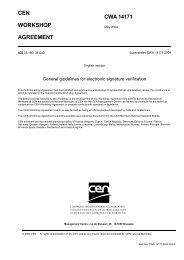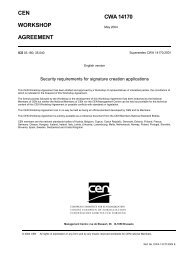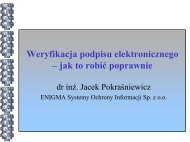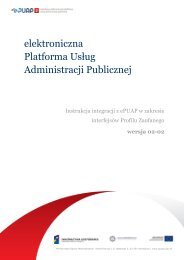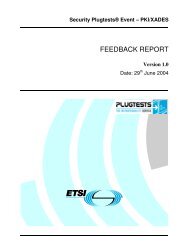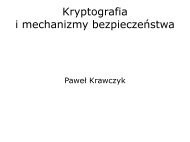When electronic signature becomes a information services ... - IPSec
When electronic signature becomes a information services ... - IPSec
When electronic signature becomes a information services ... - IPSec
You also want an ePaper? Increase the reach of your titles
YUMPU automatically turns print PDFs into web optimized ePapers that Google loves.
existent, in that the 5 per cent use is based on the statistics from the Central Statistical Office –<br />
especially if compared to other countries such as Denmark, where it is over 60 per cent. 50<br />
Instead of the promised savings and increase in the take-up of <strong>electronic</strong> invoicing, a number of<br />
pathological business practices started to appear to work around the flawed legislation.<br />
From 2009, several companies with a large end-user base, such as Telekomunikacja Polska<br />
S.A., started to issue e-invoices using a QES, because they presumably saw it as a way to<br />
reduce the costs while preserving the legal requirement to provde the invoice to consumers. But<br />
the increased value of security was questionable because of how it was implemented.<br />
Consumers received an unsigned PDF with the invoice in one file and a detached QES<br />
<strong>signature</strong> in another file. The <strong>signature</strong> could be verified only by using a special program from<br />
the vendor, which meant the users merely looked at the unsigned PDF and ignored the<br />
<strong>signature</strong> file. This is a perfect example of how the implementation of security can be perfectly<br />
legal and perfectly useless in reality. Other companies on the other hand, especially small and<br />
medium size companies, resolved the problem of the restrictive e-invoice regulations by<br />
exchanging plain, unsigned PDF files by e-mail, which the recipient printed and dealt with as if<br />
they received the invoice as a paper invoice through the postal service. If they did not do this, it<br />
would not be possible to deduct the VAT – and it was virtually impossible to prove for the tax<br />
inspection that the document did not arrive by post. 51<br />
A positive example was Denmark where, from 1 February 2005, after creating an usable<br />
framework called OCES, it was made compulsory for both public entities and their suppliers to<br />
use e-invoices. 52 Since then, many countries have followed with flexible and purpose-oriented<br />
e-invoicing legal frameworks (Sweden, Finland, Italy, as mentioned in the European E-<br />
Invoicing Final Report. As result, more than 60 per cent of all invoices in use were <strong>electronic</strong><br />
ones in Denmark as of 2007, including all invoices exchanged with the public administration. 53<br />
50<br />
Sylwia Śmigiel, Piotr Poznański, ‘E-faktura szansą dla firm’, 1 April 2009, article in Gazeta Wyborcza.<br />
51<br />
In June 2009, a decision of the NSA (Naczelny Sąd Administracyjny) finally ruled that it is legal to send invoice contents in a PDF<br />
by way of e-mail, print it and treat as a paper invoice – without using technical means required for fully <strong>electronic</strong> invoicing (case I FSK<br />
1444/09). This is, however, just one ruling in favour of one specific company and did not reduce the confusion for the others, as the tax<br />
authorities may, but are not forced to use this ruling in other cases.<br />
52<br />
http://www.epractice.eu/cases/EID.<br />
53<br />
In Denmark, the ‘Act pertaining to public payments’ was passed in December 2003. For more on e-invoice regulation, see<br />
‘European E-Invoicing Final Report’, (European Commission Informal Task Force on e-Invoicing, 2007, Version 3.2 Final)<br />
http://ec.europa.eu/internal_market/payments/einvoicing/index_en.htm. Among other observations, the authors noted at page 22 that ‘Given<br />
this penchant for overkill in <strong>signature</strong> requirements for <strong>electronic</strong> invoices, it should come as little surprise that EDI-based solutions tend to<br />
dominate in the market, since it is more flexible from a legal point of view.’ In addition, the authors also remarked (page 22) that ‘From a<br />
cross-border perspective, it should be noted that the necessity of an invoice being legally valid in both the sender’s and the recipient’s<br />
countries means that the strictest legal regime will determine the requirements to be met. Thus, a European e-Invoicing service provider under



